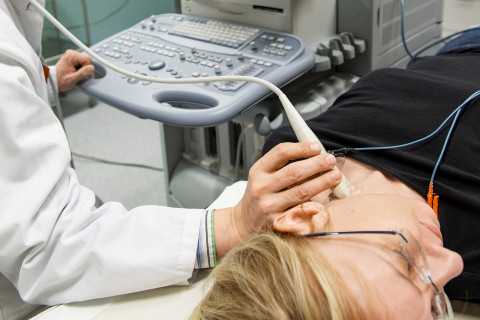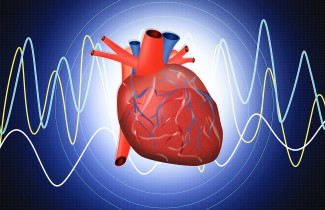The doctoral dissertation of Helena Taivainen, MSc, MD, confirms that measuring the longitudinal motion of the common carotid artery is a feasible method for evaluating vascular health.
The vascular disease process starts already in childhood or adolescence. There is a problem in detecting the pathological process in time because manifestations of the disease process only appear decades later when permanent structural alterations have already taken place. The Vascular Biomechanics Research Group in Kuopio University Hospital has developed a new non-invasive ultrasound imaging analysis software for measuring the biomechanical characteristics and especially the longitudinal motion of the carotid artery wall. This analysis software opens new possibilities with which to investigate the subclinical vascular changes that precede the later manifesting cardiovascular diseases. The magnitude of longitudinal motion within the vascular wall is similar to that of radial motion. Measuring the longitudinal motion is challenging for technical reasons and it is only recently with advances in modern ultrasound equipment with a high frame has it been possible to gather detailed information about arterial structure. This method has been under development by other research groups. In Taivainen’s dissertation, the new in-house method for analysing longitudinal motion developed in the Vascular Biomechanics Research Group was applied for the first time in clinical research; this represents a notable step forward in validating the new method. The subjects of Taivainen’s thesis were from the on-going national multicentred study of atherosclerosis precursors in Finnish children and young adults - The Cardiovascular Risk in the Young Finns Study. Kuopio centre data is from the year 2007, when the 27-year follow-up was conducted. Total of 465 subjects were evaluated in whom vascular examinations had been conducted and 292 successful longitudinal motion analysis had been performed. The cross-sectional substudies consisted of 281-292 participants aged between 30 and 45 years. Analysing the ultrasound-video data from the common carotid arteries produced new knowledge of the biomechanical characteristics of the carotid arteries. No corresponding study had previously been performed in such a large, well-characterized and homogenous study population of this age where the longitudinal motion of common carotid artery wall had been evaluated as a marker of vascular health.
The results revealed that the longitudinal motion occurred only partly in the same direction as the blood flow. The main part of the motion was directed backwards against the blood flow. Elastic arteries displayed a larger backward motion and a greater total amplitude of the longitudinal motion than stiffer arteries. Instead, stiffening of the arteries was associated with a minor longitudinal total amplitude and especially with the restriction of its backward oriented component.
In Taivainen’s dissertation, the peak-to-peak and retrograde amplitudes of the longitudinal motion were indirectly associated with blood pressure and body mass index. Retrograde longitudinal motion was also inversely correlated with total cholesterol and triglycerides. It was found that the forward oriented component of longitudinal motion increased when diastolic blood pressure, total cholesterol, LDL and triglyceride levels were elevated, and body weight increased. Furthermore, the backward component of longitudinal motion and the total amplitude decreased and antegrade oriented increased as the number of risk factors increased. The magnitude of correlation coefficients between parameters of carotid artery wall longitudinal motion and risk factors was comparable with those for traditional measures, intima-media thickness and distensibility. In the third substudy, the presence of metabolic syndrome and insulin resistance caused disturbances in the longitudinal motion. Especially, hypertension, obesity and hyperinsulinemia were associated with reduced total peak-to-peak and retrograde amplitudes and increased antegrade amplitudes. This finding indicates that longitudinal motion reacts also to the disruption glucose metabolism.
Measuring the longitudinal motion is a rather new method with which to investigate vascular health at the level of the vasculature and Taivainen’s dissertation confirms the concept emerging from a few previous studies. As a new finding, carotid stiffness parameters were associated with the longitudinal motion and the presence of the metabolic syndrome and insulin resistance as well as compensatory hyperinsulinemia caused longitudinal motion disturbances in the common carotid artery. The longitudinal motion of the common carotid artery reflects the status of vascular health and it was found to represent the changes in the state of the vascular bed, especially in the subclinical phase of arteriosclerosis but also significant associations with primary atherosclerotic risk factors were found. The longitudinal motion of the common carotid artery is a rather new phenomenon, and the results confirm the concept that measuring the longitudinal motion is a feasible method for evaluating vascular health.
The doctoral dissertation of Helena Taivainen, MSc, MD, entitled Carotid artery longitudinal wall motion in the assessment of preclinical arteriosclerosis, will be examined at the Faculty of Health Sciences. The Opponent in the public examination will be Professor Jukka Kemppainen of the University of Turku, and the Custos will be Professor Tomi Laitinen of the University of Eastern Finland and Kuopio University Hospital. The public examination will be held in Finnish online on 15 January 2021 starting at 12 noon.
Dissertation online: Taivainen, Helena. Carotid artery longitudinal wall motion in the assessment of preclinical arteriosclerosis



